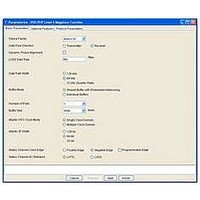IP-POSPHY4 Altera, IP-POSPHY4 Datasheet - Page 76

IP-POSPHY4
Manufacturer Part Number
IP-POSPHY4
Description
IP CORE - POS-PHY Level 4 SPI 4.2 Interface
Manufacturer
Altera
Type
MegaCorer
Datasheet
1.IP-POSPHY4.pdf
(144 pages)
Specifications of IP-POSPHY4
Software Application
IP CORE, Interface And Protocols, COMMUNICATION
Supported Families
Arria GX, Cyclone, HardCopy, Stratix
Core Architecture
FPGA
Core Sub-architecture
Arria, Cyclone, Stratix
Rohs Compliant
NA
Function
POS-PHY Level 4 Interface, Link-Layer/PHY Layer
License
Initial License
Lead Free Status / RoHS Status
na
Lead Free Status / RoHS Status
na
- Current page: 76 of 144
- Download datasheet (3Mb)
5–4
POS-PHY Level 4 MegaCore Function User Guide
Data Processor (tx_data_proc)
1
Whenever a port is not selected, or exhausts its credit-counter register, the contents of
the next-credits holding register are loaded into the credit-counter register, and the
next-credits register is cleared. The next-credits register remains at zero until the next
status update is received.
As data is transmitted for a selected port, the credit-counter register is decreased. If
the credit counter ever has insufficient credits for an entire burst unit size transfer, the
scheduler switches to another port. This port cannot send again until the credits-
counter register is reloaded with the contents of the next-credits holding register.
Therefore, the MaxBurst1 and MaxBurst2 values must be greater than or equal to the
burst unit size value.
If the buffer runs out of data before the credit-counter register reaches zero, the
scheduler switches to another port. The leftover credits remain available until a new
status message causes the credit counter to be overwritten with fresh credits. The port
may be selected again before the next status update if the buffers fill again.
Both the next-credits and credits-counter tables are cleared when a loss of status sync
(LOSS) occurs, resuming to normal behavior when the LOSS is cleared.
The scheduler normally switches when the credits are exhausted or the port runs out
of data. If the scheduler switch on EOP feature is turned on, the scheduler also
switches to another port when an EOP is sent.
The data processor consists of two sub-blocks.
Atlantic Conversion
This block packs the data from the Atlantic interface into SPI-4.2 format.
Normally, this block enables data to be transferred from the transmit scheduler to the
Atlantic FIFO buffer. If ignore backpressure is disabled, a satisfied status for any port
causes the enable to drop at the next burst unit size boundary and data is not
transferred. This backpressure mechanism is described in
Embedded Addressing” on page
The MegaCore function cannot force insertion of control words except when the
address changes or there is insufficient data to send, regardless of the buffer type.
Control Word Insertion, DIP-4, and Training Pattern Insertion
This block inserts control words into the data path, and performs DIP-4 calculation
and insertion.
An EOP-abort condition can be generated on the SPI-4.2 interface by asserting
aN_atxerr with a valid aN_atxeop on the Atlantic interface. This condition is the only
one for which the EOP-abort bit is set in the transmitted control word.
This block also inserts the training pattern at the interval defined by the Maximum
Training Sequence Interval parameter (MaxT). If the status channel is receiving a
continuous framing pattern on the status channel, the MegaCore function sends
training patterns continuously.
5–2.
Chapter 5: Functional Description—Transmitter
“Shared Buffer with
December 2010 Altera Corporation
Block Description
Related parts for IP-POSPHY4
Image
Part Number
Description
Manufacturer
Datasheet
Request
R

Part Number:
Description:
IP CORE Renewal Of IP-POSPHY4
Manufacturer:
Altera
Datasheet:

Part Number:
Description:
IP Thermal Transfer Printer With Peel/Present Option
Manufacturer:
BRADY

Part Number:
Description:
CYCLONE II STARTER KIT EP2C20N
Manufacturer:
Altera
Datasheet:

Part Number:
Description:
CPLD, EP610 Family, ECMOS Process, 300 Gates, 16 Macro Cells, 16 Reg., 16 User I/Os, 5V Supply, 35 Speed Grade, 24DIP
Manufacturer:
Altera Corporation
Datasheet:

Part Number:
Description:
CPLD, EP610 Family, ECMOS Process, 300 Gates, 16 Macro Cells, 16 Reg., 16 User I/Os, 5V Supply, 15 Speed Grade, 24DIP
Manufacturer:
Altera Corporation
Datasheet:

Part Number:
Description:
Manufacturer:
Altera Corporation
Datasheet:

Part Number:
Description:
CPLD, EP610 Family, ECMOS Process, 300 Gates, 16 Macro Cells, 16 Reg., 16 User I/Os, 5V Supply, 30 Speed Grade, 24DIP
Manufacturer:
Altera Corporation
Datasheet:

Part Number:
Description:
High-performance, low-power erasable programmable logic devices with 8 macrocells, 10ns
Manufacturer:
Altera Corporation
Datasheet:

Part Number:
Description:
High-performance, low-power erasable programmable logic devices with 8 macrocells, 7ns
Manufacturer:
Altera Corporation
Datasheet:

Part Number:
Description:
Classic EPLD
Manufacturer:
Altera Corporation
Datasheet:

Part Number:
Description:
High-performance, low-power erasable programmable logic devices with 8 macrocells, 10ns
Manufacturer:
Altera Corporation
Datasheet:

Part Number:
Description:
Manufacturer:
Altera Corporation
Datasheet:

Part Number:
Description:
Manufacturer:
Altera Corporation
Datasheet:











